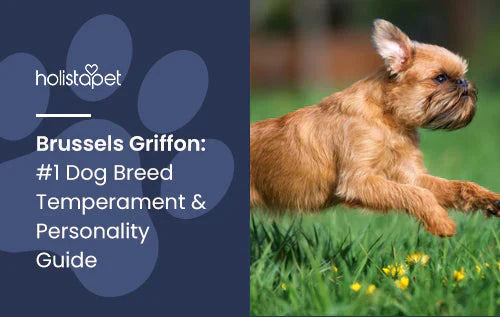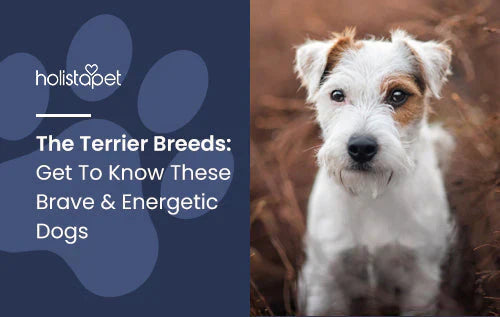Ever seen a dog with a beard? Allow me to introduce the Brussels Griffon! This adorable toy breed is brimming with personality, and their Wookie charm sweeps people off their feet. Hailing from Belgium, the Brussels Griffon is one of the most intelligent furballs around town. This dog will keep you on your toes, and there's no end to what their fiery brussels griffon temperament has in store. Brussels Griffons steal the hearts of every owner that has the pleasure of raising one. They're phenomenal show dogs that also steal the competition in any ring.
Physical Characteristics
Maybe it's the shape of their face; perhaps it's the symmetry of their features, or maybe it's the beard that some sport. Whatever it is, it's undeniable that the Brussels Griffon has a very human-like expression! Their eyes are very far apart, and their nose is always black (and relatively short). The Brussels Griffon's natural ears are half erect and floppy, although cropping is common. The face is flat and resembles that of an Ewok.
This toy breed has a short but sturdy body. The arched neck leads to a level, muscular back. The Brussels Griffon has a long tail that is set high, although you will often see them cropped to about a third of the length. The forelegs are straight and set far apart, while their hind legs bend at the stifles.
Size
The Brussels Griffon stands only 7-10 inches tall! The average adult weighs between 7-11 pounds. This lightweight pooch has more than enough personality to make up for their tiny size, though.

Personality
The Brussels Griffon pros and cons is like a two-headed dragon, or a Gemini, or whatever you can think of that has dual personalities. On one side, they're a bit bossy and love to exercise their assertiveness. On the other hand, they're soft and sensitive dogs that cherish your affection. This breed forms close bonds with their owners and loves sticking close to their side. They are intelligent, confident, and loving.
You'll find that a Brussels Griffon traits puts on a dominant persona around others, but melts into an affectionate pup when in the comfort of their family home. Like all intelligent breeds, the Brussels Griffon can be prone to stubbornness when it comes to training. They can be very sensitive as well and will pick up on peoples' moods.
Exercise
Brussels Griffons need at least 30 minutes of exercise daily, but more is recommended. The activity should include walks, playtime, and mental stimulation. Take care when exercising this breed - their short noses make them prone to overheating. Frequent breaks help to prevent them from suffering heat strokes caused by exercise.
This breed is fairly active indoors, so you don't need a large yard to provide them with adequate exercise. Although a Brussels Griffon can run circles around your couch for days, they need walks to burn up their energy. Walks provide some mental stimulation since they expose your Brussel Griffon to various sights, sounds, and smells.
RELATED: Mental Stimulation for Dogs: Why It's Important & Best Activities Explained
Toys provide both stimulation and exercise for your Brussels Griffon. You can get your Griffon to chase a frisbee or pull a rope until they tire out. Moving toys also activate your dog's natural instinct to chase, and they can offer phenomenal stimulation for your Brussels Griffon.
Brussels Griffon Training
The key to training a Brussels Griffon is patience. This breed will learn commands easily, but it can take some time to convince them that education is worth their while. Making training sessions fun sets your Brussels Griffon up for success! Including treats and play in your training sessions will keep your Griffon engaged.

If your dog is turning a stubborn cheek, you can try using different reinforcers, moving to a different setting, or taking a step back and practicing the last command they performed well. Repetition will build your dog's discipline and confidence. Your Griffon won't want to repeat the same routines, but if you keep the sessions short, they shouldn't have an issue. Recital drives those commands home!
Brussels Griffon History
The Brussels Griffon descended from a Belgian terrier breed known as the Griffon d'Ecurie. These rough-coated terriers kept stables rodent-free, and they were a favorite among Belgian coachmen. The Griffon d'Ecuries were bred with pugs around the mid 18th century, resulting in smooth-coated Brussels Griffons called Brabancons. The breeding continued, and Brabancons were soon crossed with King Charles and English Toy Spaniels.
hese pairings resulted in two distinct coat lines: the rough-coated Griffons and smooth-coated Griffons. Red, black and tan, and solid black color variations emerged as well. The American Kennel Club recognized the first Brussels Griffon in 1910. The breed continues to be a popular pet in the United States and Belgium.
Brussels Griffon Health Problems
These fun little furballs don't come without a few health concerns! Your Griffon can lead a long and fulfilling life as long as they receive adequate veterinary care. Always be sure to keep up with vaccinations, preventative care, and routine checkups.
Hip Dysplasia
Hip dysplasia is common in many toy breeds. This condition occurs when the ball-and-socket joint that makes up the hip structure connects abnormally, leading to degradation and painful joint grinding. Hip dysplasia is genetic, and some owners try to minimize it by promoting the mobility of the dog's hip joints and keep their system healthy. Pain management is crucial for this condition!
Patellar Luxation
Patellar luxation occurs when your dog's patella (their "knee bone") dislocates from its usual position and affects their mobility. Although this isn't painful for your dog, it will cause them to limp or avoid moving the affected limb. The only way to correct this condition is through surgery.
Progressive Retinal Atrophy
Progressive retinal atrophy (PRA) is a degenerative condition that slowly degrades your dog's vision. PRA causes the photoreceptor cells in your dog's retina to die, eventually leading to blindness. Unfortunately, there is no treatment or cure for progressive retinal atrophy.
Distichiasis
Distichiasis refers to an extra eyelash in the margin of the eyelid. Although this doesn't sound like a big deal, due to the eyelash's sensitive location, it can often irritate the eye. Not every dog with distichiasis will experience issues. If the eyelash causes irritation, symptoms may include redness, inflammation, and excessive tearing.
How to Care for a Brussels Griffon
Caring for your Griffon is a walk in the park once you get acclimated to their routine. Still, getting down their basic grooming, exercise, and feeding regime is essential. Your Brussels Griffon is bound to put a smile on your face every day, so their care should be your first priority!

Nutrition and Feeding
They don't require much food due to their small size. Still, their food needs to be nutritious and balanced. This breed does well on a grain-free diet as many Griffons are allergic to grain. Brussels Griffons should eat three times a day until they are six months old. Puppies that are two months old require 0.1 cups of dog food daily. You can bump that amount up to 0.15 cups daily when they are three months old. High-quality, dry food is the ideal choice for this breed.
Once your they are six months old, you can begin feeding them 0.25 cups of food daily in two meals. At 12 months old, they should eat about 0.4 cups of food a day. This small breed gains weight quickly! Try not to leave food out around the clock as this encourages extra snacking.
Coat Color And Grooming
Brussels Griffons come in four different hues: red, beige, black and tan, and solid black. The red and beige varieties typically have some brown fur mixed in their coat pattern. Black markings around the face are common as well. Black and tan Griffons may have reddish-brown markings on their face and under the chin.
RELATED: CBD treats for dogs
How to Groom
Fortunately, Brussels Griffons don't shed much. The smooth-coated Brussels Griffons are easier to groom - a weekly brushing and occasional bath are all that is required to keep their coat healthy. Rough-coated Griffons need to be hand-stripped every three months to maintain their texture.
To hand strip your Griffon, take some of their fur between your pointer finger and thumb and gently pull. The dead hair trapped in the undercoat should fall away easily if it's ready to shed. If the fur doesn't give, move on to another section and try. An experienced groomer can show you how to get this technique down, as it takes some practice to master.
The rest is basic hygiene. Your Griffon's teeth should be brushed at least three times a week to prevent dental decay. Try to trim your Griffon's nails once or twice a month. Also, be sure to bathe regularly using shampoo suitable for sensitive skin and check their ears about once a week to clean out any dirt or build-up.
Children And Other Pets
Brussels Griffons are not the most kid-friendly breed. They don't have the patience to be chased or hugged, and they may find a child's play or behavior annoying. Your Griffon won't snap at every youngster that comes their way, but keep in mind that they can get weary of children's antics. Still, it's important that you expose your Griffon to plenty of children when you socialize them.
Griffons are more tolerant of other animals. They don't have a strong urge to chase other pets, and they can share space with other dogs if they're adequately socialized. Some Griffons may think they are bigger than they are, so expose them to other dogs to keep that attitude in check!

Rescue Groups
The National Brussels Griffon Rescue, Inc. is a non-profit organization dedicated to saving lost, abandoned, and abused Griffons. They neuter, spay, and provide other veterinary care for every rescue that comes through their shelter. The National Brussels Griffon Rescue, Inc works hard to find loving forever homes for their dogs.
The American Brussels Griffon Rescue Alliance is a nationwide rescue program that houses Griffons through their dedicated foster network. They vaccinate and microchip all their rescues, so their dogs never really get lost ever again. ABGRA maintains stringent adoption policies to ensure their Griffons go to only the best-suited homes.
Breed Organizations
The American Brussels Griffon Association is the official parent-club affiliated with the grand American Kennel Club. The organizations strive to protect and advance the Brussels Griffon breed through special shows and events. Members of ABGA get access to their bulletin and a robust network of services for their dogs.
The National Brussels Griffon Club was founded in 1971 to promote responsible Griffon breeding. The club can point you in the direction of a reliable breeder that ensures their litters are healthy and up to breed standards. The National Brussels Griffon club also publishes its own magazine with informative articles, news, and ads related to the breed.
More About This Dog Breed
Brussels Griffons are picky eaters! Although they're fussy about food, they can eat a lot if you let them. These dogs are hard to breed because the mothers often need cesarean sections. The average life span for a Brussels Griffon is 12 to 14 years. If you want a little Chewie of your own, find yourself a Griffon. These little dogs are a joy to keep, and they'll keep you smiling day after day.







![Probiotics For Dogs [Soft Chews] - HolistaPet](http://www.holistapet.com/cdn/shop/files/Probiotic-Infographic-1_472d7a29-e30c-435a-9638-1365d8c3a9f9.jpg?v=1725384841&width=104)



























Leave a comment
All comments are moderated before being published.
This site is protected by hCaptcha and the hCaptcha Privacy Policy and Terms of Service apply.